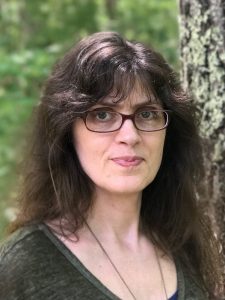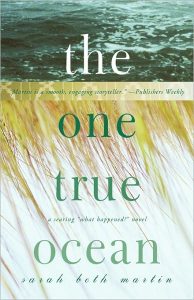Seduced by Landscape
 A sense of place. What first truly evoked this for me was the nineteenth-century English countryside of Jane Eyre, with its heather knolls and stone halls set against wild, thorny wood. Then came Wuthering Heights, and its ominous, misty moors. These dreamy, gothic landscapes not only stirred my imagination, but fueled my desire to write the kind of stories I write now.
A sense of place. What first truly evoked this for me was the nineteenth-century English countryside of Jane Eyre, with its heather knolls and stone halls set against wild, thorny wood. Then came Wuthering Heights, and its ominous, misty moors. These dreamy, gothic landscapes not only stirred my imagination, but fueled my desire to write the kind of stories I write now.
It wasn’t the first time literary landscapes had inspired me. There had been Dorothy’s Kansas in the Oz books–hot, flat and gray, Fern’s lush farm in Charlotte’s Web, the kaleidoscopic world of Alice in Wonderland. And of course, all those fairy tales set in twilight forests and English castles. My childhood was rich with colorful settings, and my fanciful, heavily illustrated writing reflected this.
But the Bronte sisters’ novels introduced me to a new kind of mist-shrouded landscape that was both chilling and romantic, and their stories mirrored this. Even the most pristine vista masked some dark secret. Words had subtext, and no longer embodied the organized romanticism of childhood. Emotional conflict lurked in every corner. Adventure was replaced by love, and magic was something nuanced, indefinable. I was hooked.
Every story invites a reader into a unique landscape. But landscape isn’t just a setting; it’s what happens when we filter our surroundings through our own eyes and mind. In writing, it’s nearly impossible to transcribe every detail of a scene, so the reader is left to invent part of it. Even the most detail-oriented writers leave the minutia up to the imagination of the reader. So, in effect, don’t readers all end up with a different interpretation?
I’ve often wondered how readers have visualized my work. The little yellow house in my first novel, The One True Ocean, has a bedroom with layers of torn wallpaper. A few miles away, a stone jetty leads into a dark, mysterious sea. Readers may visualize the fictional town of Cape Wood as I do, but chances are, they see it quite differently. The settings are a blend of my surroundings and experiences, something only I can remember and feel. I was renting a yellow house when the story first sparked, and the wallpaper was straight out of my childhood home. The jetty is a real jetty in southern Maine, relocated to a place in my imagination. And even familiar snapshots like these get modified over time, transformed by insights and experiences, the filter of the mind. Landscape is a unique blend of setting, experiences and perceptual tendencies. The possibilities are endless.
I do have a weakness for a mist-shrouded landscape. It doesn’t have to be a velvet mist over the Yorkshire moorland. It can be a hazy cityscape or a fog in a cemetery. It can be a luminescent beam of dust in sunlight. In The One True Ocean, it’s the fog that hovers at the shoreline, the cloud that casts a shadow on the water. These haunting features of the coastal Maine setting not only reflect the story, they helped inspire it. Sometimes I fall so in love with a landscape that I have to resist the temptation to adapt my story to it. Landscape can be a powerful distractor.
My recently completed novel lives in such an enticing place—beautiful, mysterious, and with a real history. Norumbega Park was a glorious amusement site that once stood along the banks of the Charles River in Massachusetts, not far from my childhood home. Growing up, I only knew the site as a modern hotel across the river from a picnic area. When I learned the park had existed there a century before, I was intrigued, and a story was born. While the setting of my novel is pure New England, the landscape still is shrouded in mist. I suppose I can’t help myself.
 What is it about the mist? Is it simply that it’s both foreboding and beautiful, all that dark and light? Or that it’s a veil, hinting at something to be revealed? I’m not sure if Jane Eyre or Wuthering Heights created my obsession with mist-shrouded landscapes, or if it’s just an adult version of my fairy tale obsession from childhood, my way of holding on. Or maybe it goes even deeper—to some kernel of memory from my ancestors in Ireland and Scotland.
What is it about the mist? Is it simply that it’s both foreboding and beautiful, all that dark and light? Or that it’s a veil, hinting at something to be revealed? I’m not sure if Jane Eyre or Wuthering Heights created my obsession with mist-shrouded landscapes, or if it’s just an adult version of my fairy tale obsession from childhood, my way of holding on. Or maybe it goes even deeper—to some kernel of memory from my ancestors in Ireland and Scotland.
My novel in progress brings me back to this gothic landscape that inspired me years ago. The dual narrative story takes place on a sprawling country estate in both early and modern-day Ireland. It includes themes of family secrets and lineage. Characters struggle with repression and identity. Conflicts and mysteries thrive in a landscape of layered social classes and hedge mazes! In such a landscape, it’s difficult not to drape a mist upon everything, and get lost in it.
Another novel in the works (I tend to multi-task) features a more domestic, contemporary setting in which diverse characters’ lives intertwine. As much as I’d like to indulge in the mist-shrouding, there are no moors, meadows or twilight forests in the story. However, it does feature a view outside a window that is misty and blurred, as syrupy bands of rain drizzle over glass.
The mist is everywhere—in books and films, on television and travel blogs, in advertising. I see that glistening cloud and a hint of whatever hides behind it, and I begin to dream. I imagine some buried secret or hidden past, and all the lives surrounding it. This is how stories begin.
—
Sarah Beth Martin grew up in Massachusetts among creative parents and siblings. Her fiction and creative non-fiction have appeared in several literary journals and magazines, and her novel, The One True Ocean, was published in the U.S. and Germany. Sarah has just completed her second novel, and has too many new ones in progress. She lives in Maine with her husband and three children.
Find out more about her on her website
http://www.sarahbethmartin.com/
Follow her on Twitter https://twitter.com/SBethMartin
—
About The One True Ocean
There are two oceans, mom used to tell me. There is one that is blue-a clean, bright Disney World blue, which simply is the mirror of a clear sky above. But look at the ocean on a cloudy day, she would say, and here lies the green ocean-the true ocean, full of algae and kelp and slimy creatures, evil lurking in the shadows.
The One True Ocean is a searing “what happened?” novel driven by suspense and tension when a twenty-something artist returns to her abandoned childhood home and begins to dig into her past. In a search for answers to her aunt’s suicide and her father’s identity, Jenna discovers that her seaside house holds dark secrets that will unravel her family history and shatter the truth she has come to believe.
In this eloquent debut novel, Sarah Beth Martin mixes dark psychology and real emotion with breathless storytelling to explore the deep connections between past and present, love and loss, the dead and the living.
Buy the book HERE
Category: Contemporary Women Writers, On Writing

























